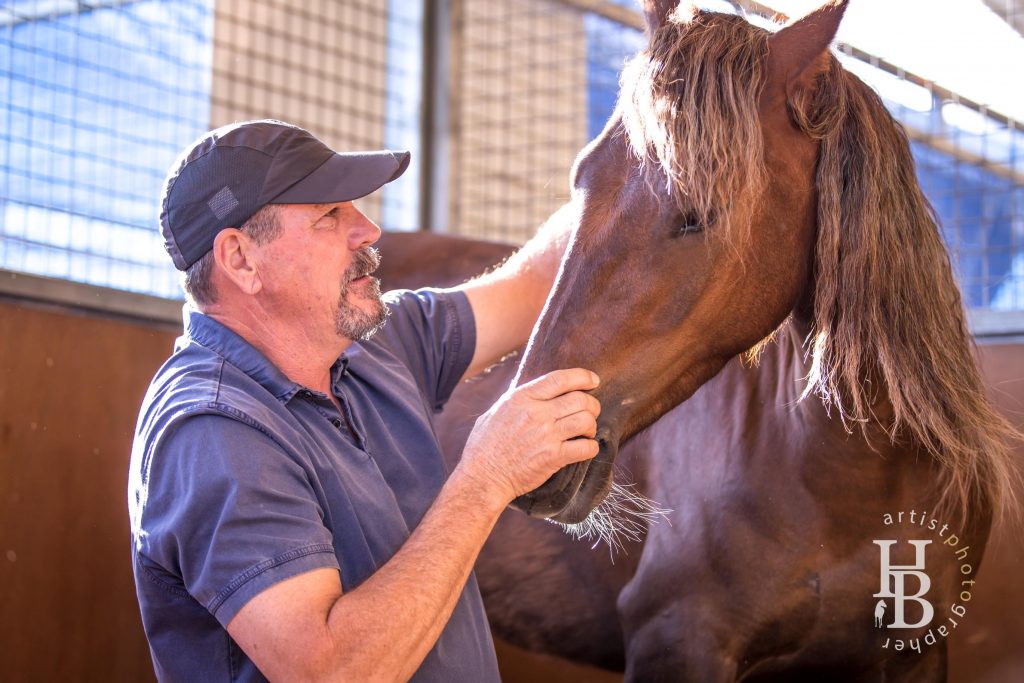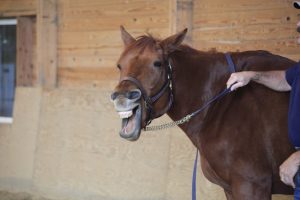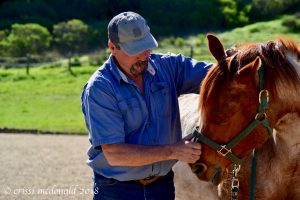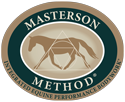
After the Bladder Meridian Technique, the Lateral Cervical Flexion technique is the first step toward releasing tension in the poll and atlas and asking for movement in this area. The reason why it is one of the first techniques to start with is because of the importance of the main junction we want to address: the poll-atlas-junction.
This junction is arguably the most important of the three key junctions of the horse’s body inasmuch as performance is affected. By helping the horse release tension in this junction we will get an improved bending and suppleness in the poll and neck, and extension and suspension in the front end. Pain and tension anywhere in the horse’s body is reflected in the poll. Conversely, when tension accumulates in the poll, things start going wrong in the rest of the body. As important: release of tension in the poll and atlas will release tension in the entire body.
Anatomy close-up:
Since this junction is so important, it is well worth it that we have a look anatomically at the whats and wheres of it:
- Poll: the occiput, located at the top of the horse’s head.
- Atlas (C1): the first and most important of all the cervical vertebrae. If you search for it with your hand, behind and to the side of the poll, you will feel a hollow space one inch behind the horse’s jaw and, just behind that, a bony bump or ridge. That ridge is the wing of the atlas.
- Axis: the second cervical vertebra or C2. From the atlas, slide your fingers a few inches farther down toward the direction of the shoulder and you will feel a flat area. The axis itself can not be felt, but it is located underneath this flat area.
- Additional cervical vertebrae (C3, C4, C5, C6 and C7): they do not follow the top line of the neck, but run down the lower part of the neck. To find them, from the atlas run your fingers down along the thickest part of the neck. You will not feel the axis, but in a few inches you will feel a bump, which is the third vertebra, or C3 then the following vertebrae until you reach C6. You will not be able to feel the seventh, C7, because it is underneath the shoulder blade. It might be easier to explore this part of the anatomy in a skinny horse.
When we work with the horse in this area, we release tension in the soft tissue interconnection of the poll, the cervical vertebrae, and major muscles that attach to these structures. Tension in these important muscles around the poll and atlas affect performance in other parts of the horse’s body. Some of these major muscles that affect movement and performance are:
- Brachiocephalic or head to arm muscles, involved in moving the head from side to side, pulling the scapula forward, raising the scapula in collection and bringing the foreleg forward.
- Omotransverse muscles, also involved in raising the scapula and bringing the foreleg forward.
Releasing Tension: the effects
As we mentioned before, pain and tension anywhere in the horse’s body is reflected in the poll. And when tension accumulates in the poll, it affects the rest of the body. For example:
- Pain in the forelimb or foot can cause tension and pain through the muscles in the neck and into the muscles of the poll and atlas. Excessive loading in one forelimb can cause more tension and stiffness on that same side of the neck, causing resistance to bending in that direction. This can eventually cause problems with the respective lead and lead changes, overloading the opposite front limb and leading to soreness or lameness in that limb, as well as affecting the diagonal hind limb and restricting movement in the body overall.
- Pain in the saddle area or back can create tension in the area of the top of the poll. Tension through the muscles of the back and top line along the supraspinous and nuchal ligaments contract the back and create tension and pain in the poll. The same vicious cycle of pain and tension affects the poll and back.
- The atlas and sacrum are connected. When there is tension on the atlas, there will almost always be tension on the sacrum, and vice versa. So when we release tension on the atlas, we are also releasing tension on the sacrum and when we work on the sacrum, we are also working on the atlas.
The main principles of release
 These principles apply in any Masterson Method® Technique that involves movement. When you move a horse’s joint – or junction – through its natural range of motion in a relaxed state, tension is released in that joint or junction. This is how you use the Masterson Method® to bypass the horse’s survival or bracing response and allow the horse to release tension in key joints and junctions of the body that most affect performance:
These principles apply in any Masterson Method® Technique that involves movement. When you move a horse’s joint – or junction – through its natural range of motion in a relaxed state, tension is released in that joint or junction. This is how you use the Masterson Method® to bypass the horse’s survival or bracing response and allow the horse to release tension in key joints and junctions of the body that most affect performance:
- By following the horse’s responses to your touch, you are able to stay soft and slow enough, which allows you to bypass the horse’s survival or bracing responses
- By staying soft and slow enough, you give him nothing to resist.
- By giving the horse nothing to resist, you stay under his survival or bracing response.
- By staying under his survival or bracing response, you can move the joint or junction in a relaxed state.
Always work with the horse in a relaxed state
It is important not to force techniques or movements. Some horses are more flexible than others. One horse may find it easy to bend the neck and follow your nose-hand, while another might be physically unable to reach around even half-way. Resistance may be caused by stiffness or lack of range of motion, or by soreness. In either case, go softly and don’t force it. Your goal is to release tension in the soft tissues around the vertebrae by asking them to move in a relaxed state. If you find yourself bracing against the horse, it isn’t working. Soften!
 We are only looking for an incremental improvement in range of movement each step of the way, not to try to get the horse to bend or flex beyond where he can comfortably go. Some horses are naturally stiffer than others, especially as they get older. If you get an improvement or release response each step of the way as you go along, you will get results without the risk of harming the horse. You can then go over the area again, getting improvement. Each time you go over an area and obtain releases, it’s as if you are “peeling layers of an onion”.
We are only looking for an incremental improvement in range of movement each step of the way, not to try to get the horse to bend or flex beyond where he can comfortably go. Some horses are naturally stiffer than others, especially as they get older. If you get an improvement or release response each step of the way as you go along, you will get results without the risk of harming the horse. You can then go over the area again, getting improvement. Each time you go over an area and obtain releases, it’s as if you are “peeling layers of an onion”.
Remember that you can find all the details about the Lateral Cervical Flexion Technique in the Beyond Horse Massage Book available at our Store.
And if you want to learn more about The Masterson Method® so that you can practice with your horse, join one of our hands-on Weekend Seminars to learn the Masterson Method® Techniques that you can use with your horse to improve range of motion and release tension.
